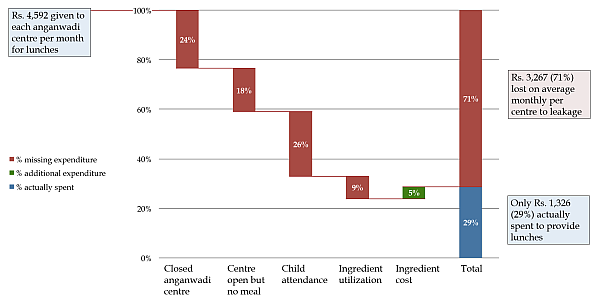The prevalence of underweight children in Bihar is higher than in any country in the world, and the provision of public services to address malnutrition is poor. Based on an assessment of the government’s nutritional support to mothers and children, this column sheds light on the grim public service delivery, likely causes, and ideas to address the problem.
Bihar’s child malnutrition rate is higher than any country in the world (Menon et al 2009, Grebmer et al 2011). Over half of the children under five years of age are underweight or stunted, indicating chronic malnourishment (NFHS-3)1. Recognising this, the Bihar state government and the central government have committed over Rs. 1,100 crore ($200 million approx.) per year for the Supplementary Nutrition Programme (SNP) administered by the Directorate of Integrated Child Development Services (ICDS). However, programme funds are regularly pilfered, and on-the-ground public service delivery is lacking.
We, together with our team at IDinsight2, conducted a study to quantify the extent and sources of this pilferage using unannounced visits by independent surveyors (IDinsight 2013)3. We find that 53% of SNP funds are not spent on the ground, amounting to an annual loss of nearly Rs. 600 crore ($110 million approx.).4 The two main components (and sources of leakage) for SNP are hot cooked meals for three to six year olds, and take-home rations (THR) for pregnant and lactating mothers and children younger than three. Each anganwadi (government run pre-school) is provided with around Rs. 4600 ($ 80 approx.) and Rs. 5800 ($ 105 approx.) per month for hot cooked meals and THR respectively. We find that 71% of funds meant for hot cooked meals and 38% of THR funds are pilfered5.
Finally, it should be noted that this study is not about the efficacy of SNP itself. There is no clear evidence that SNP, even if functioning well, reduces malnutrition (Lokshin et al 2005). In fact, owing to SNP’s low coverage6 poor targeting of impoverished households (Gragnolati et al 2006) and intended beneficiaries within households7, and lack of focus on very young children, it may not have the desired nutritional impact.
However, while these design issues should be addressed, improving the status of SNP is vital from a public service delivery point of view. This requires an understanding of potential causes of poor performance, design changes to address these, field pilots to optimise design changes, and rigorous impact evaluations to learn if they have the desired effect. This is a model for how social sector organisations can diagnose problems, experiment with ideas, and scale up ideas that are proven to work. Our study, in fact, serves as the foundation for such an approach, in which two interventions to improve public service delivery in Bihar ICDS will be piloted and rigorously evaluated.
Sources of fund leakage
In unannounced visits to 200 anganwadis across three districts of Bihar8, 24% of them were closed during times they should have been open, and meals were only served on 59% of the days they should have been served. When anganwadis were open and meals were served, only 22 children on average out of 40 that should attend were present. And in these meals, only three quarters of the stipulated nutritional ingredients were used.
Figure 1 below illustrates how each of these factors contributed to the final tally of 71% of funds allocated for hot cooked meals not being spent. Closed anganwadis and poor child attendance together account for two-thirds of the missing expenditure.
Interestingly, ingredient prices are fixed by ICDS across Bihar and are sometimes not adjusted for 2 to 3 years, despite high inflation. Due to this, ingredients needed to prepare the meals cost around 20% more than the amount allocated by ICDS. However, because of the low expenditure in the first place, this only increases expenditure by 5 percentage points (see Figure 1).
Figure 1. Missing expenditure on hot cooked meals

Approximately 38% of funds are missing from THR, which provides bags of rice and lentils to young children and mothers. Although, 84% of beneficiaries reported receiving some rice and lentils during the past month, two thirds of the missing expenditure under the THR component is due to low volumes of rice and dal. Often, beneficiaries lament that they only got a handful of lentils, while books showed that the anganwadi worker provided them with 2 kilos of lentils.9
What factors contribute to this status quo?
Our team’s extensive field visits and stakeholder interviews have shed light on the possible causes for the widespread pilferage or the proverbial ‘last mile problems’ of ICDS10.
There are few mechanisms to hold service providers accountable. From the demand-side, beneficiaries do not seem to be aware of their entitlements. Parents have often told us that they are “satisfied” because their children at least get “something”. Additionally, anganwadi workers seem to have significant discretion in choosing beneficiaries, and families may worry they will be struck off the beneficiary list if they complain. In many surveys, beneficiaries made efforts to ensure that we did not record anything negative about their local anganwadi worker.
We also found that parents may not consider their children malnourished.11 Therefore, SNP is likely treated as just a little extra food rather than a fundamental necessity (since the problem of hunger is not as acute as that of malnourishment in the state12), further reducing its demand.
On the supply side, monitoring by ICDS officials is highly infrequent. According to our study, only 21% of anganwadi workers (rather than the expected 60% if the official ICDS guidelines are followed)13 had received visits from their Child Development Project Officer (CDPO) in the past three months.14 In addition, the anganwadis where supervisors visited were no more likely to provide a meal, suggesting the ineffectiveness of the current monitoring system.15 Moreover, performance tracking of the entire ICDS hierarchy (and not just the anganwadi workers) is inadequate.
Systemic issues within ICDS in Bihar may encourage front line workers to fudge accounts or steal, which is a slippery slope for larger amounts being pilfered. For example, anganwadi workers almost never get paid on time. They receive honorariums for six to nine months in one go, and typically with a significant and unpredictable lag. Some workers have admitted to us that, given this situation, it is only natural to siphon off SNP funds, which arrive monthly. Similarly, some anganwadi workers are reputed to have paid huge sums of money16 to attain their positions. In such cases, siphoning off SNP funds is viewed as a “right” of the anganwadi worker, as they feel justified in getting monthly pay-offs given their large upfront “investment”.
As mentioned earlier, food prices are fixed by ICDS and are lower than market prices.17 Our study found that market prices were on average more than 20% higher than ICDS stipulated rates.18 Therefore, even the most honest anganwadi workers buy less than the stipulated quantity. This then makes it very difficult to hold errant workers accountable, as market prices provide a ready justification to explain non-provision of meals (“money ran out”), or lesser quantities of key ingredients (“lentils are too expensive”).
Ideas to improve Bihar’s nutrition programme
Leadership at Bihar’s Department for Social Welfare and ICDS has proposed two interventions to improve SNP and requested rigorous evaluations of the same.
The first intervention uses technology to facilitate demand- and supply-side accountability. On the demand side, a call centre will randomly call beneficiaries to solicit information on the functioning of their local anganwadi, and to pass on information such as guidelines on their entitlements, updates on financial transfers to their anganwadi worker, an assessment of their local anganwadi etc. This could solve the above mentioned problems of beneficiaries not knowing their rights, and the risk of losing benefits when demanding better service19. However, it remains to be seen whether information alone is sufficient to empower the beneficiaries to demand better service, given on-the-ground caste and power dynamics between anganwadi workers and beneficiaries.
On the supply side, supervisory officials will receive smartphones with an anganwadi-monitoring application, GPS and camera to increase the frequency, quality, transparency and verifiability of their monitoring reports. Data from these monitoring visits and from beneficiary reports will be aggregated to suit different stakeholders, and made available publicly. To be effective, the information generated through this intervention should be consistently used to manage and incentivise20 all levels of the ICDS staff.
The second intervention is to administer SNP via JEEViKA21 self-help groups. This has the potential to increase demand side accountability, as 50% of ICDS beneficiaries in JEEViKA-operated blocks are members of these self-help-groups. This would address the previously mentioned problem of beneficiaries being afraid to demand better services on their own. Here too a rigorous evaluation will be critical to determine the efficacy of this intervention, especially given this will be a new role for JEEViKA.
Concluding thoughts
There are no sure solutions to reduce leakage and improve the provision of food to Bihar’s millions of malnourished children and mothers. We plan to iteratively pilot the suggested interventions on the ground to optimise their design, and undertake rigorous evaluations to measure their effects on nutritional service delivery and beneficiary outcomes.
The eagerness of the Government of Bihar and ICDS to innovate and adjust programme design, and to use rigorous evaluations to inform their decisions, provides hope for millions throughout Bihar. This model of innovating, learning from evidence, and using these to improve on-the-ground public service delivery is a model for government departments all over India.
This column is a direct result of extensive deliberations within IDinsights India team, which includes Neil Buddy Shah, a Founding Partner at IDinsight, and Associates Apurva Bamezai, Anand Kothari, and Stuart Shirrell.
Notes:
- As per the National Family Health Survey (NFHS-3) for Bihar conducted in 2005-2006, 56% of children under-five are underweight, and 56% are stunted.
- IDinsight uses rigorous evaluations as a decision-making tool for policy makers and managers. Read more here: www.IDinsight.org.
- For the full study, click here: http://www.theigc.org/publications/working-paper/quantitative-assessment-beneficiary-nutritional-status-and-performance. This study serves as the foundation on which to iteratively pilot and then rigorously evaluate two interventions aimed at reducing pilferage in this important government programme.
- If the performance in the rest of the state and throughout the year is similar to the surveyed areas and survey period.
- While our measurements are at the anganwadi level, we are not suggesting that anganwadi workers pilfer all the funds. Anecdotal evidence suggests that pilfered funds are distributed among other village-level officials and are sent up the hierarchy as well. Due to the non-transparent and illegal nature of such pilferage, we were not able to capture this formally in our study. Attempts to ask sensitive corruption-related questions to anganwadi workers and beneficiaries based on established survey methods for such questions (randomised response technique, corruption perception surveys etc.) were not effective in this context.
- Using ICDS’ “Know Your Anganwadi” dataset, we calculated that ICDS is only reaching 31% of the eligible beneficiaries of the state.
- We find that 98% of beneficiaries share THR with others in the family. This is critical because undernourishment during a child’s first 1000 days affects lifelong indicators of malnourishment and health, and even education and income levels (Ruel, 2010).
- Districts were chosen to ensure representation from Bihar’s major linguistic regions, covering geographical variations. In addition, the average across the three districts on key parameters such as literacy and gender ratio were very similar to the Bihar average. More details on our methodology can be found in the full report.
- The exact entitlement of rice and lentils per beneficiary depends on their registered nutritional category.
- Please note these are hypotheses and have not been tested formally. Our future work will rigorously evaluate interventions designed to address some of these causes. You can read about it here: http://www.3ieimpact.org/en/evidence/impact-evaluations/details/723/
- This is corroborated in the HUNGaMA report 2011 (HUNGaMA 2011), which shows that only 7.6% of mothers in the 112 “focus districts” across 9 states surveyed had even heard the word ‘malnutrition’ in their local language.
- Prevalence of calorie-undernourishment in Bihar is 17.3% (Menon et al 2009), which is far lower than malnourishment indicators of underweight children (56%).
- Based on authors’ calculations
- Similarly, low visit rates were found for Lady Supervisors, vis-à-vis their expected visit-rate.
- Of course, we are only reporting a correlation (association) here between performance and supervision. We recognise the real possibility of reverse causality, wherein more monitoring visits may be done in poorly functioning anganwadis.
- We have heard that sums ranging from Rs. 40,000 to Rs. 200,000 ($700 to $3,600 approx.) are paid to attain positions. However, this has not been verified. Also, please note that many of these sums are from 5 to 10 years ago (or longer), and hence, their current value adjusted for inflation will be much higher.
- ICDS is currently updating prices, which were last fixed as far back as 2008, based on information from IDinsight’s survey and other sources. ICDS is also considering entering a more flexible pricing system to reflect market realities better.
- We visited 172 shopkeepers to collect price intelligence, and also asked anganwadi workers and beneficiaries about prices of foodstuffs.
- On the assumptions that beneficiaries can be convinced that their feedback is anonymous, which it is.
- To read more on motivating India’s community workers, read Nava Ashraf’s column on Ideas for India:https://www.ideasforindia.in/topics/macroeconomics/how-to-motivate-indias-community-workers.html, and a synthesis of J-PAL research on incentives for attendance here: http://www.povertyactionlab.org/publication/absenteeism-showing-first-step
- World Bank funded government body facilitating women’s self-help-groups in Bihar. Read more here: www.brlp.in
Further Reading
- IDinsight (2013), ‘Quantitative Assessment: Beneficiary Nutritional Status and Performance of ICDS Supplementary Nutrition Programme in Bihar’, International Growth Centre, Patna.
- Menon, P., Deolalikar, A., & Bhaskar, A. (2009), ‘India State Hunger Index: Comparison of hunger across states’, Washington, D.C., Bonn, and Riverside: International Food Policy Research Institute, Welt Hunger Hilfe, and University of California Riverside.
- Grebmer, K. V., Torero, M., Olofinbiyi, T., Fritschel, H., Wiesmann, D., Yohannes, Y., et al. (2011), ‘Global Hunger Index. The Challenge of Hunger: Taming Price Spikes and Excessive Food Price Volatility, Bonn, Washington, D.C., Dublin: International Food Policy Research Institute, Concern Worldwide, and Welt Hunger Hilfe.
- Lokshin, M., Gupta, M. D., Gragnolati, M., & Ivaschenko, O. (2005), “Improving Child Nutrition? The Integrated Child Development Services in India”, Development and Change, 613-640.
- Gragnolati, M., Bredenkamp, C., Gupta, M. D., Lee, Y. K., & Shekar, M. (2006) “ICDS and Persistent Undernutrition: Strategies to Enhance the Impact”, Economic and Political Weekly , 1193-1201.
- Ruel, M. T. (2010) “The Oriente Study: Program and Policy Impacts”, The Journal of Nutrition, 415-418.
- Hungama (2011), ‘The Hungama Survey report – 2011’, Naandi Foundation.
- International Institute for Population Sciences and Macro International (2007), ‘National Family Health Survey - 3, 2005-06, India: Key Findings’, Mumbai: International Institute for Population Sciences.




 24 May, 2013
24 May, 2013 





Comments will be held for moderation. Your contact information will not be made public.